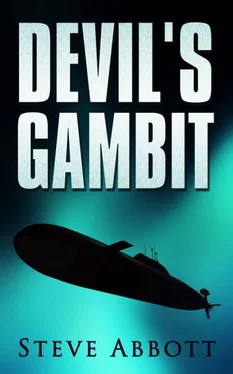The thin reed of Great Leader’s search antenna cut a narrow wake through rolling gray waves. A lone antenna sniffing for stray emissions from airborne and surface search enemy radars.
Two hundred miles off the port quarter of the Leader’s stern lay the island of Taiwan. To their starboard side lay the Ryuku Islands archipelago. Underneath the waves, the Leader’s bow-mounted passive sonar array translated distant pings of American ship sonar and sonobouy nets into a cascade display of electronic light on a CRT screen above the sonar station. Underneath, two of the Leader’s sonar officers sat, headphones clamped over their ears. Long, thin fingers made delicate changes to the audio receivers. It was a constant struggle to sort out a picture of what was going on above and below the surface from pure noise.
The proximity of the Leader to the surface did not help matters. A great deal of information was being lost in the wave clutter.
Captain Kil-yon leaned over the illuminated map table, studying a series of RORSAT-generated maps so detailed that they showed every bump and ripple in the ocean floor from Indonesia to the Sea of Japan. Currents, their depths and calculated salinity levels were shown with transparent overlay bands of different colors.
American Naval Intelligence would have given a great deal to find out how these maps had been acquired for the North Korean Navy through a series of cut out companies from a subsidiary of the same French company that supplied satellite reconnaissance of downtown Kuwait to the Iraqis during the first Gulf War. The North was still a closed society to the west. Try as they might, spies of any consequence were few and far between. Most of the information garnered by western intelligence services came from Japanese sources laid down in the Second World War during their occupation. A dubious information source at best. In fact, all of the American intelligence community would have been fascinated at just how advanced the North Korean sensor, fire control and command suites were for such a small, diesel submarine.
Thanks to a worldwide recession, like-minded European and American companies would sell to anyone, restrictions or not, if the paperwork was in order. Secret trading partners waved the ways if the means of wealth were justified. The submarine’s builders had used this greed to purchase the absolute best off the shelf western technology they could lay their hands on into his hull. The Leader’s Captain knew this and planned to exploit the enemy task force commander’s lack of information.
The young lieutenant monitoring the search antenna looked up from his display. “No airborne search radars, sir.”
The Captain acknowledged this with the barest of nods, his eyes and brain still mapping the threats to his sub and possible routes through the American picket line. He silently gave the enemy task force commander grudging credit. “Helm, all stop.”
“Helm answering. All stop.”
The Americans had extensive sonobouy nets lining all the approaches. The DICASS nets were a real problem. Command activated and directional, they had the ability to extend their hydrophones below fifteen hundred feet. The drawback of using the DICASS type buoy to the Americans’ was its duration of only thirty minutes. Short life or not, they could seriously hamper his approach through deep water to the strait.
Once in the strait, he would be more at the mercy of buoys that had shallower depth ability but greater staying power, some as long as eight hours. The Americans could turn buoys from passive to active at the press of a few buttons. The buoys moved with the currents. Each one had a location marker that allowed a computer to plot each net’s progress. The Leader could pass under a net and not realize it until high frequency pings were reverberating off her hull and torpedoes and anti-submarine weapons were splashing into the water.
The Captain hoped the silence of full stop would allow his sonar officer to get a better picture of just how many ships were involved in whatever the Americans were doing. He turned to his sonar officer. “I need an approximate tally of the number and type of ships that we may be facing.”
“Aye, sir.”
The Captain hoped that none of the Oliver Hazard Perry Class Frigates were detected. Their SQS-5 sonar array worked extremely well in shallower waters. He hoped the shallow strait between the lower tip of Japan and South Korea would degrade American sonar performance enough to let him slip through, but that belief had slipped from his grasp at the first distant pings.
The strait was at the end of the long flat underwater Yellow Sea plain. A crevasse at its base ran deep from between Taiwan and mainland China, gradually getting shallower as it closed on the tip of South Korea. The flat shelf of the Korea straits, in some places only six hundred feet deep, ended at the edge of a cliff that dropped down into the deep abyssal of the Sea of Japan. The sheer-faced underwater mountains, the deep waters of the Sea of Japan and the tectonic instability of the sea floor in that region were the Leader’s ticket home. The Captain knew that with his skill and a little luck, he could avoid the surface ships and lurking submarines of the Americans. His real worry were anti-submarine warfare aircraft equipped with Magnetic Anomaly Detection equipment. These were sensors on long booms that extended behind an aircraft which detected the magnetic disturbance a large, ferrous metal object like a submarine would cause to the Earth’s magnetic field. There were many wrecks in the region that he could use as decoys to hamper the effectiveness of the American search.
His thoughts were interrupted by his sonar officer. “High frequency sonars to the port bow, sir. I count at least three. Screws turning for ten to fifteen knots. It’s at the extreme range of my hydrophones, so I can’t be sure.”
An active search pattern. “Damn!” the Captain tried to keep his consternation to himself. Were they looking for him? They must be. That blasted helicopter back at the freighter transfer and they had dropped a torpedo, not that it had even gotten close. Still, there was no way they could know it was a Korean operation. Unless it had been compromised from the start.
He was going to need a diversion if he was going to get through. He scrawled a brief message on a sheet of paper, folded it in half and handed it to an ensign. “Get that to communications. Send it out by burst transmission. Move quickly, man, we haven’t got all day.”
The ensign dashed off to the CCR.
His best chance lay in following the thermocline that ran along the long shelf that spanned the Philippines tip right to the bottom edge of Japan. He could use the layer between the two different water temperatures to mask his almost-silent running signature. The thermal layer would protect them from bow- and hull-mounted passive sonar. Ships equipped with dipping- and towed-array sonar were a worry, but their own passive sonar array had shown them to be at extreme distance.
Still, if they were trolling with their towed array positioned in just the right place and detected the Leader’s presence, their reaction could bring patrolling American submarines, the greatest underwater threat.
Another sub was the only weapons platform truly effective against a submarine threat and the Americans always had their underwater dogs patrolling the yard. If all these dangers could be avoided, all that would be required for assured success would be a quick race through the shallow waters of the Korea Straits into the deeper and safer waters of the Sea of Japan. The American commanding officer maybe expected him to run as close to Pyongyang as possible, right through his picket line. The Captain shook his head. That made little sense. The Yellow Sea was a large, flat, shallow area. The Leader would be easy picking. They did not have the true number of enemy ships nor their positions. One thing was clear: there were many ships, but they were used to peacetime waters. Submariners the world over were used to operating in an environment that was as close to a war footing as could be achieved. The Captains of the American ships would be tacticians, not warriors.
Читать дальше












